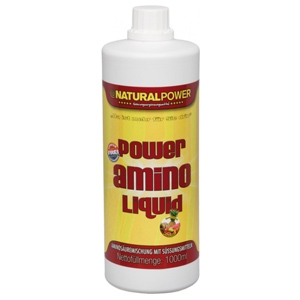Natural Power Amino Liquid Review
Amino Liquid is a product from Austrian based company Natural Power. The product description claims that it allows a rapid absorption and a rapid supply to the muscles due to it being in a liquid form. This review will aim to analyse the ingredients to understand how they do this.
Ingredients
Drinking water
Protein hydrolyzate
Protein hydrolyzate has been found to absorb more rapidly than free form amino acids and intact proteins (1), which can lead to a greater delivery to muscles and a greater post exercise muscle protein synthesis after exercise (1). It has been shown that wheat protein hydrolyzate can increase insulin response dramatically and is ideal for recovery post exercise (2).
Fructose
Fructose is a simple carbohydrate and is an intermediary in the metabolism of glucose (3). It has a low caloric value, low glycemic index (4) and gives a sweeter taste (5).
Citric acid
The main function of citric acid is the reduction of physical fatigue (6). The reason for this is due to citric acid being a major component of the tricarboxylic acid (TCA) cycle. TCA cycle is the process of converting carbohydrates, fats and proteins into carbon dioxide and water (7). By increasing citric acid it activates the TCA cycle and in turn speeds up ATP production thus replenishing energy.
Blood orange flavour
Glycerin
Glycerin is a thick colourless, odourless liquid which has been suggested to be a hyper hydrating agent (8). The main reason for this is that it can increase blood osmolality which augments the retention of water (9). It has been suggested to lower heart rate and prolong exercise (10), however research is still sparse on this ingredient further studies are needed in order to fully understand the capabilities of glycerin.
Potassium sorbate
Potassium sorbate is a preservative and helps prevent mould and fungus which can prevent products from spoiling.
Sodium benzoate
Sodium benzoate is an antimicrobial preservative that helps prevent mould and fungus which can prevent products from spoiling.
Sweetener (sodium cyclamate, acesulfame K, saccharin)
Sodium cyclamate, acesulfame K and saccharin is a sweetener that is calorie free. This ingredient is used in many products and is used to make the product taste sweeter and does not have any nutritional benefit.
Pyridoxine hydrochloride
Pyridoxine hydrochloride is a form of Vitamin B6. The active form of vitamin B6 is known as P-L-P (11), which is stimulated by exercise (12). During exercise the body relies on the liver to produce glucose via glycogenolysis, for which vitamin B6 is essential for, and is an integral part of the glycogen phosphorylase enzyme and thus will provide energy to the bodies’ muscles (13).
Summary
This product states that the amino acids allow fast, rapid absorption into the muscles, this product can achieve this by the form that this supplements is in. The amino acids can help increase muscle mass, other ingredients within this supplement can help increase the time to fatigue and recovery from exercise. It is recommended that this product be taken either pre or post exercise. This product has no banned substances when referring to the WADA prohibited list when observing the label/ ingredients posted on the website.
*NOTE – This product has not been tested in a laboratory and may contain other substances that may not appear on the label
References
1 – van Loon, L. J., Kruijshoop, M., Verhagen, H., Saris, W. H., & Wagenmakers, A. J. (2000). Ingestion of protein hydrolysate and amino acid–carbohydrate mixtures increases postexercise plasma insulin responses in men. The Journal of nutrition, 130(10), 2508-2513.
2 – Manninen, A. H. (2004). Protein hydrolysates in sports and exercise: a brief review. Journal of sports science & medicine, 3(2), 60.
3 – Racker, E. (2009). Alternate pathways of glucose and fructose metabolism.Advances in Enzymology and Related Areas of Molecular Biology, 15, 141.
4 – White, J. S. (2008). Straight talk about high-fructose corn syrup: what it is and what it ain’t. The American journal of clinical nutrition, 88(6), 1716S-1721S.
5 – Kyriazis, G. A., Soundarapandian, M. M., & Tyrberg, B. (2012). Sweet taste receptor signaling in beta cells mediates fructose-induced potentiation of glucose-stimulated insulin secretion. Proceedings of the National Academy of Sciences, 109(8), E524-E532.
6 – Sugino, T., Aoyagi, S., Shirai, T., Kajimoto, Y., & Kajimoto, O. (2007). Effects of citric acid and L-carnitine on physical fatigue. Journal of clinical biochemistry and nutrition, 41(3), 224.
7 – Baldwin, J. E., & Krebs, H. (1981). The evolution of metabolic cycles.
8 – WAGNER, D. (1999). Hyperhydrating with glycerol: implications for athletic performance. Journal of the American Dietetic Association, 99(2), 207-212.
9 – Robergs, R. A., & Griffin, S. E. (1998). Glycerol. Sports Medicine, 26(3), 145-167.
10 – Montner, P., Stark, D. M., Riedesel, M. L., Murata, G., Robergs, R., Timms, M., & Chick, T. W. (1996). Pre-exercise glycerol hydration improves cycling endurance time. International Journal of Sports Medicine, 17(01), 27-33.
11 – Ubbink, J. B., Vermaak, W. J., van der Merwe, A., & Becker, P. J. (1993). Vitamin B-12, vitamin B-6, and folate nutritional status in men with hyperhomocysteinemia. The American journal of clinical nutrition, 57(1), 47-53.
12 – Manore, M. M. (2000). Effect of physical activity on thiamine, riboflavin, and vitamin B-6 requirements. The American journal of clinical nutrition, 72(2), 598s-606s.
13 – Manore, M. N., Leklem, J. E., & Walter, M. C. (1987). Vitamin B-6 metabolism as affected by exercise in trained and untrained women fed diets differing in carbohydrate and vitamin B-6 content. The American journal of clinical nutrition,46(6), 995-1004.

| Use for | Muscle Gain |
| Website | naturalpower.at |
| Price | €19.90 |




